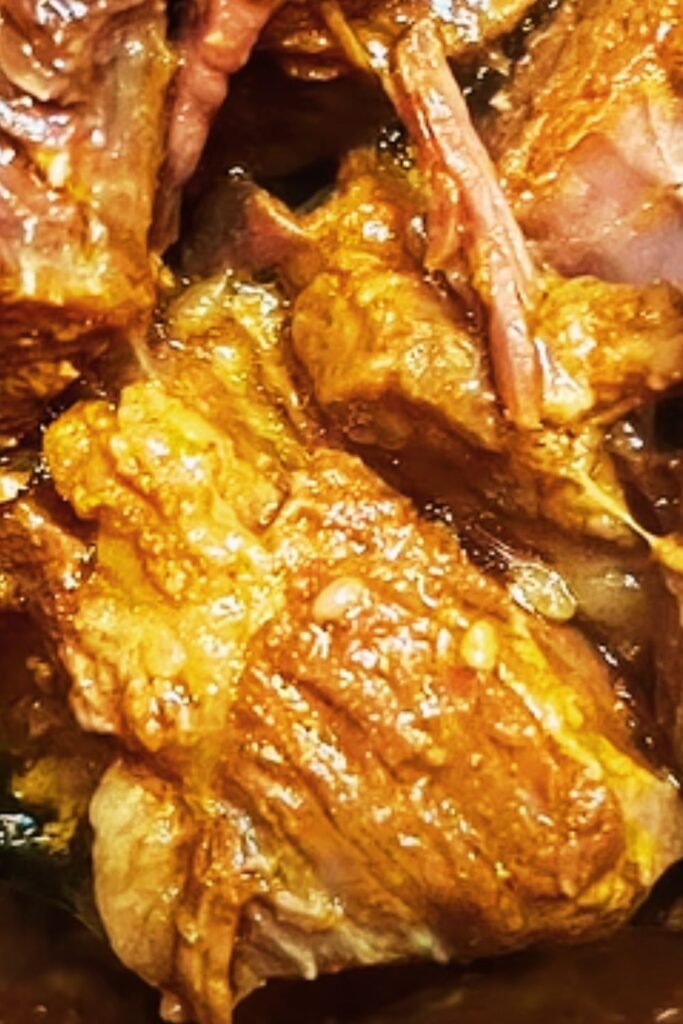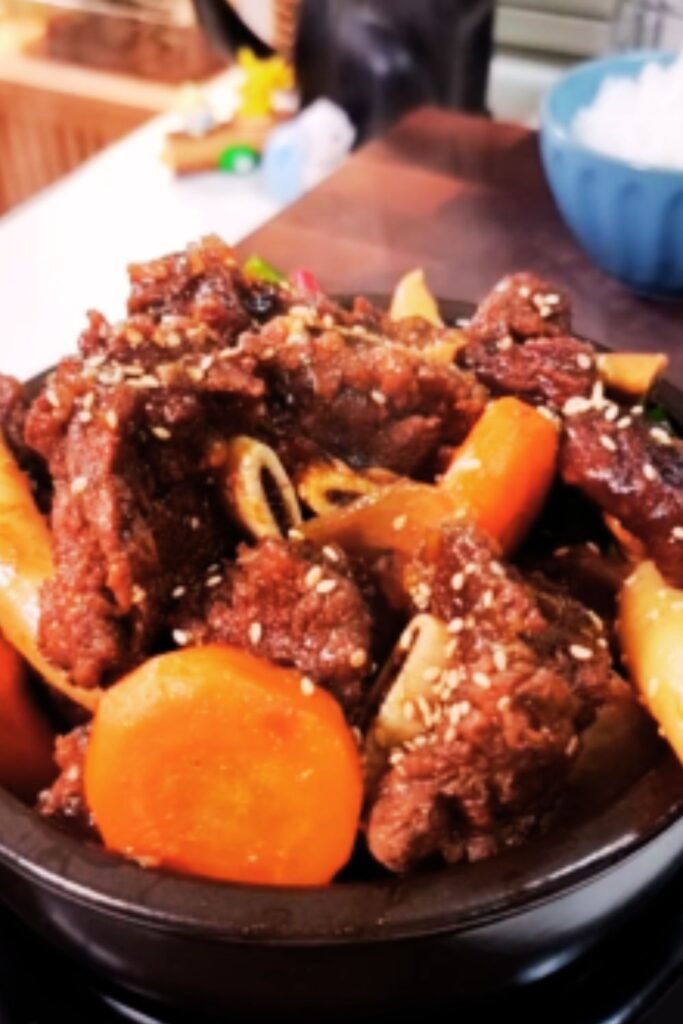There’s something magical about walking into your home after a long day and being greeted by the mouthwatering aroma of dinner that’s been slowly cooking to perfection. As someone who juggles work, family, and everything in between, I’ve come to rely on my slow cooker as my secret weapon for creating memorable meals with minimal effort. Today, I’m sharing one of my absolute favorite recipes that never fails to impress: Slow Cooker Korean Beef.
This isn’t just any beef recipe – it’s a beautiful marriage of sweet, savory, and slightly spicy flavors that transform an affordable cut of beef into something extraordinary. The meat becomes so tender it practically melts in your mouth, absorbing all those delicious Korean-inspired flavors as it cooks low and slow throughout the day.
I first discovered this recipe years ago when I was looking to expand my slow cooker repertoire beyond the usual pot roasts and stews. Since then, I’ve tweaked and perfected it, finding the ideal balance of ingredients that create that authentic Korean flavor profile while still being approachable for anyone to make at home with ingredients you can find at your local supermarket.
What Makes Korean Beef Special?
Korean cuisine is known for its bold, well-balanced flavors, and this beef dish is no exception. Traditional Korean beef dishes like Bulgogi typically feature thinly sliced beef marinated in a mixture of soy sauce, sugar, sesame oil, garlic, and other ingredients that create a distinctive sweet-savory profile with a hint of heat.
This slow cooker version takes those same flavor principles but adapts them for the long, slow cooking process. Instead of thinly sliced beef that cooks quickly, we use a larger cut that benefits from hours of gentle cooking, allowing it to become fork-tender while absorbing all those wonderful flavors.
The Perfect Cut of Beef
For this recipe, I recommend using beef chuck roast. This affordable cut comes from the shoulder area of the cow and is perfect for slow cooking because:
- It has excellent marbling (fat distribution throughout the meat)
- It contains connective tissue that breaks down during slow cooking
- It becomes incredibly tender when cooked low and slow
- It absorbs flavors beautifully
Chuck roast is often sold as “pot roast” or “chuck shoulder” in grocery stores, making it easy to find. At around $5-7 per pound (depending on your location), it’s also budget-friendly compared to premium cuts like ribeye or tenderloin.
Essential Ingredients for Authentic Flavor
The sauce is where the magic happens in this recipe. Here are the key ingredients that create that distinctive Korean flavor profile:
Soy Sauce: The foundation of the sauce, providing that umami-rich saltiness. I recommend using low-sodium soy sauce to better control the salt level in the final dish.
Brown Sugar: Provides sweetness that balances the salty soy sauce. The molasses content in brown sugar adds depth that regular white sugar lacks.
Sesame Oil: This aromatic oil brings a nutty flavor that’s distinctively East Asian. A little goes a long way!
Gochujang: This Korean red pepper paste adds complex heat and depth. If you can’t find it, a combination of sriracha and miso paste can work as a substitute.
Garlic and Ginger: These aromatic powerhouses are essential in Korean cooking, providing a fragrant foundation.
Rice Vinegar: Adds brightness and cuts through the richness of the beef.
Asian Pear: This might be a surprise ingredient for some, but it’s traditional in Korean marinades. The enzymes in the pear help tenderize the meat while adding subtle sweetness.

The Recipe: Slow Cooker Korean Beef
Ingredients
For the Beef:
- 3-4 pounds beef chuck roast, cut into 2-inch chunks
- 1 tablespoon vegetable oil (if searing the beef)
- 1 large onion, sliced
- 2 carrots, cut into 1-inch pieces (optional)
For the Sauce:
- ½ cup low-sodium soy sauce
- ⅓ cup brown sugar, packed
- 2 tablespoons sesame oil
- 2 tablespoons rice vinegar
- 3 tablespoons gochujang (Korean red pepper paste)
- 6 garlic cloves, minced
- 2 tablespoons fresh ginger, grated
- ½ Asian pear, grated (or substitute with a sweet apple)
- 1 tablespoon fish sauce (optional but recommended)
- ¼ teaspoon black pepper
For Serving:
- Steamed white rice
- Sliced green onions
- Toasted sesame seeds
- Kimchi (store-bought or homemade)
- Quick-pickled cucumbers (recipe below)
- Steamed broccoli or bok choy
Instructions
- Prepare the beef: Trim excess fat from the chuck roast and cut into 2-inch chunks. Pat dry with paper towels.
- Sear the beef (optional but recommended): Heat vegetable oil in a large skillet over medium-high heat. Working in batches to avoid overcrowding, sear the beef chunks on all sides until browned (about 2-3 minutes per side). Transfer the seared beef to your slow cooker. Note: While you can skip this step and still have delicious results, searing creates a deeper flavor through the Maillard reaction.
- Prepare the sauce: In a medium bowl, whisk together soy sauce, brown sugar, sesame oil, rice vinegar, gochujang, minced garlic, grated ginger, grated pear, fish sauce (if using), and black pepper until well combined.
- Combine in slow cooker: Add sliced onions and carrots (if using) to the slow cooker with the beef. Pour the sauce over everything and gently stir to ensure all pieces are coated.
- Cook: Cover and cook on low for 7-8 hours or on high for 4-5 hours. The beef is ready when it’s fork-tender and easily pulls apart.
- Shred and reduce (optional): About 30 minutes before serving, remove the beef and shred it using two forks. If you’d like a thicker sauce, transfer the liquid to a saucepan and simmer until reduced by about one-third. Return the shredded beef to the slow cooker (with the reduced sauce if applicable) and continue cooking for the remaining time.
- Serve: Serve the Korean beef over steamed rice, garnished with sliced green onions and toasted sesame seeds. Add your choice of sides such as kimchi, quick-pickled cucumbers, and steamed vegetables.
Quick-Pickled Cucumbers
Ingredients:
- 1 English cucumber, thinly sliced
- 2 tablespoons rice vinegar
- 1 tablespoon sugar
- ½ teaspoon salt
- ½ teaspoon Korean red pepper flakes (gochugaru) or regular red pepper flakes (optional)
Instructions:
- Combine rice vinegar, sugar, salt, and red pepper flakes (if using) in a bowl, stirring until sugar dissolves.
- Add cucumber slices and toss to coat.
- Let sit for at least 15 minutes before serving, or refrigerate for up to 24 hours.
Nutritional Information
Understanding the nutritional content of what we eat is important for making informed dietary choices. Here’s a breakdown of the approximate nutritional values per serving (assuming 8 servings from this recipe):
| Nutrient | Amount per Serving | % Daily Value* |
|---|---|---|
| Calories | 385 | – |
| Total Fat | 18g | 23% |
| Saturated Fat | 6g | 30% |
| Cholesterol | 115mg | 38% |
| Sodium | 820mg | 36% |
| Total Carbohydrates | 15g | 5% |
| Dietary Fiber | 1g | 4% |
| Sugars | 12g | – |
| Protein | 42g | 84% |
| Vitamin D | 0mcg | 0% |
| Calcium | 30mg | 2% |
| Iron | 5mg | 28% |
| Potassium | 610mg | 13% |
*Percent Daily Values are based on a 2,000 calorie diet.
Note: This nutritional information is an estimate and will vary based on specific ingredients and portions.

Variations to Try
Spicy Korean Beef
If you enjoy heat, increase the gochujang to 4-5 tablespoons and add 1 teaspoon of Korean red pepper flakes (gochugaru). This will give your dish that fiery kick that many Korean dishes are known for.
Korean Beef Tacos
Transform leftovers into fusion tacos! Warm corn or flour tortillas and fill with the Korean beef. Top with:
- Quick-pickled red onions
- Cilantro
- Sriracha mayo (mix mayonnaise with a bit of sriracha)
- Lime wedges
- Sliced avocado
Korean Beef Bowls with Vegetables
Create a nutritious bowl by:
- Starting with a base of steamed rice or cauliflower rice
- Adding a portion of Korean beef
- Arranging colorful vegetables around the beef:
- Julienned carrots
- Sliced cucumbers
- Sautéed spinach with garlic
- Bean sprouts
- Sliced radishes
- Topping with a fried egg with a runny yolk
- Garnishing with sesame seeds and green onions
- Serving with gochujang sauce on the side
Make-Ahead and Storage Tips
One of the best things about this dish is how well it works for meal prep:
Freezing Uncooked:
You can prepare this recipe as a freezer meal:
- Cut the beef and place in a freezer-safe bag
- Mix all sauce ingredients in a separate container
- Freeze both separately
- Thaw in refrigerator overnight before cooking
- Combine in slow cooker and cook as directed
Storing Leftovers:
- Refrigerator: Store cooled leftovers in an airtight container for up to 4 days
- Freezer: Freeze in portion-sized containers for up to 3 months
- Reheating: Thaw overnight in refrigerator if frozen, then reheat in microwave, stovetop, or oven until heated through (165°F)
Serving Suggestions
This versatile dish pairs beautifully with numerous sides. Here are some of my favorite ways to serve it:
Traditional Korean-Style:
- Steamed short-grain white rice
- Banchan (small side dishes) like:
- Kimchi
- Seasoned spinach (sigeumchi namul)
- Bean sprouts (kongnamul)
- Korean pickled radish (danmuji)
Fusion Style:
- Serve over cauliflower rice for a lower-carb option
- Create lettuce wraps using butter lettuce or romaine hearts
- Serve over zucchini noodles or regular pasta
- Use as filling for steamed bao buns with quick-pickled vegetables
Family-Style Spread:
For entertaining, create a DIY Korean beef bowl bar with various toppings so everyone can customize their meal:
- Different bases: white rice, brown rice, quinoa
- Vegetables: steamed broccoli, sautéed mushrooms, shredded carrots
- Toppings: sliced avocado, fried garlic chips, furikake seasoning
- Sauces: extra gochujang sauce, sriracha mayo, soy sauce

Equipment Recommendations
While this recipe doesn’t require specialized equipment, here are some recommendations to make preparation easier:
Slow Cooker:
A 6-quart slow cooker is ideal for this recipe. I prefer models with:
- Programmable timers
- Keep-warm function
- Removable ceramic insert that’s dishwasher safe
Other Helpful Tools:
- Sharp chef’s knife: For cutting the beef into chunks
- Cast iron skillet: If searing the beef before slow cooking
- Microplane grater: For grating fresh ginger
- Meat claws or two forks: For shredding the beef
Common Mistakes to Avoid
- Not trimming the fat: While some fat adds flavor, too much can make the dish greasy. Trim excess visible fat before cooking.
- Overcrowding when searing: If you choose to sear the beef, work in batches to ensure proper browning. Overcrowding the pan causes the meat to steam rather than sear.
- Using regular soy sauce without adjusting: Regular soy sauce can make the dish too salty. If that’s all you have, use about 25% less and add more to taste later if needed.
- Opening the lid too often: Every time you open the slow cooker lid, you lose heat and extend cooking time. Resist the urge to peek!
- Not accounting for your slow cooker’s temperament: Some run hotter than others. If you know yours cooks hot, err on the shorter end of the cooking time range.
Frequently Asked Questions
Q: Can I use a different cut of beef?
A: Yes! While chuck roast is ideal, you can also use brisket, short ribs, or even round roast. Cooking times may vary slightly, but the principle remains the same – low and slow cooking will break down tough cuts and make them tender.
Q: I can’t find gochujang. What can I substitute?
A: While nothing exactly replaces the unique flavor of gochujang, you can mix 2 tablespoons tomato paste, 1 tablespoon sriracha sauce, 1 teaspoon honey, and ½ teaspoon miso paste as a substitute. Alternatively, use Thai chili paste (sambal oelek) mixed with a bit of honey.
Q: Can I make this in an Instant Pot or pressure cooker?
A: Absolutely! Follow the same preparation steps, then cook on high pressure for 45 minutes with a 15-minute natural pressure release. For even more flavor, use the sauté function to reduce the sauce after cooking if it’s too thin.
Q: Is this recipe gluten-free?
A: Not as written, since soy sauce contains wheat. However, you can easily make it gluten-free by substituting tamari or certified gluten-free soy sauce, and ensuring your gochujang is gluten-free (some brands are, some aren’t).
Q: How spicy is this dish?
A: As written, I’d rate it as medium spicy – enough heat to notice but not overwhelming. You can easily adjust by increasing or decreasing the amount of gochujang. For a milder version, use just 1 tablespoon; for spicier, increase to 4-5 tablespoons.
Q: Can I add vegetables to the slow cooker?
A: Yes, but add them at different times depending on the vegetable. Hearty vegetables like carrots, potatoes, and onions can go in at the beginning. Add quicker-cooking vegetables like bell peppers, snow peas, or bok choy during the last 30-60 minutes of cooking.
The History Behind Korean Beef
Korean beef dishes have a rich history dating back centuries. Historically, beef was considered a luxury in Korea, often reserved for special occasions and royalty. The most famous Korean beef dish, bulgogi (which translates to “fire meat”), was traditionally prepared for royal court cuisine during the Joseon Dynasty (1392-1910).
What makes Korean beef preparations unique is the emphasis on tenderizing the meat through various methods – whether through thin slicing against the grain, using fruit enzymes (like those found in Asian pear), or long, slow cooking methods. This tenderizing tradition developed because, for much of Korean history, beef was tough and needed these techniques to make it palatable.
The sweet and savory marinade characteristic of Korean beef evolved over generations, balancing the five Korean taste elements: sweet, sour, salty, bitter, and spicy. This balance creates the complex, crave-worthy flavor profile that has made Korean beef dishes popular worldwide.
This slow cooker adaptation maintains those flavor traditions while making the dish accessible for modern home cooks. While not strictly traditional in cooking method, it honors the spirit of Korean beef cookery by creating tender, flavorful meat with that distinctive sweet-savory balance.
Final Thoughts: Why This Recipe Works
After making this Korean beef countless times, I’ve come to appreciate why it’s such a reliable crowd-pleaser:
- Accessibility: It uses ingredients most home cooks can find, making authentic Korean flavors approachable.
- Flexibility: The recipe is forgiving and adaptable to what you have on hand.
- Convenience: Set it up in the morning and come home to a restaurant-quality meal.
- Value: It transforms an economical cut of beef into something that tastes luxurious.
- Leftovers: The flavors often intensify overnight, making next-day meals even better.
Whether you’re new to Korean cuisine or a seasoned fan, this slow cooker beef recipe offers a delicious entry point that fits into a busy lifestyle. The combination of sweet, savory, and spicy notes creates a memorable dish that will have everyone asking for seconds.
So dust off that slow cooker, gather your ingredients, and prepare to fill your home with the irresistible aroma of Korean beef. Your taste buds – and anyone lucky enough to share your table – will thank you.


